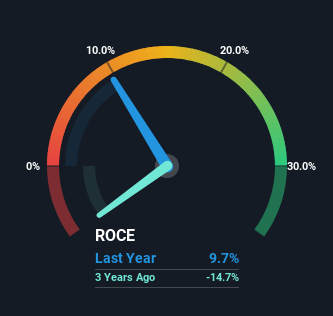- India
- /
- General Merchandise and Department Stores
- /
- NSEI:SHOPERSTOP
Returns On Capital At Shoppers Stop (NSE:SHOPERSTOP) Paint A Concerning Picture
If we want to find a potential multi-bagger, often there are underlying trends that can provide clues. Ideally, a business will show two trends; firstly a growing return on capital employed (ROCE) and secondly, an increasing amount of capital employed. This shows us that it's a compounding machine, able to continually reinvest its earnings back into the business and generate higher returns. However, after investigating Shoppers Stop (NSE:SHOPERSTOP), we don't think it's current trends fit the mold of a multi-bagger.
Understanding Return On Capital Employed (ROCE)
For those that aren't sure what ROCE is, it measures the amount of pre-tax profits a company can generate from the capital employed in its business. Analysts use this formula to calculate it for Shoppers Stop:
Return on Capital Employed = Earnings Before Interest and Tax (EBIT) ÷ (Total Assets - Current Liabilities)
0.097 = ₹2.5b ÷ (₹53b - ₹27b) (Based on the trailing twelve months to June 2024).
Thus, Shoppers Stop has an ROCE of 9.7%. In absolute terms, that's a low return, but it's much better than the Multiline Retail industry average of 5.4%.
See our latest analysis for Shoppers Stop

Above you can see how the current ROCE for Shoppers Stop compares to its prior returns on capital, but there's only so much you can tell from the past. If you'd like, you can check out the forecasts from the analysts covering Shoppers Stop for free.
What Can We Tell From Shoppers Stop's ROCE Trend?
When we looked at the ROCE trend at Shoppers Stop, we didn't gain much confidence. Around five years ago the returns on capital were 20%, but since then they've fallen to 9.7%. Meanwhile, the business is utilizing more capital but this hasn't moved the needle much in terms of sales in the past 12 months, so this could reflect longer term investments. It may take some time before the company starts to see any change in earnings from these investments.
On a related note, Shoppers Stop has decreased its current liabilities to 51% of total assets. So we could link some of this to the decrease in ROCE. Effectively this means their suppliers or short-term creditors are funding less of the business, which reduces some elements of risk. Since the business is basically funding more of its operations with it's own money, you could argue this has made the business less efficient at generating ROCE. Keep in mind 51% is still pretty high, so those risks are still somewhat prevalent.
In Conclusion...
In summary, Shoppers Stop is reinvesting funds back into the business for growth but unfortunately it looks like sales haven't increased much just yet. Yet to long term shareholders the stock has gifted them an incredible 116% return in the last five years, so the market appears to be rosy about its future. However, unless these underlying trends turn more positive, we wouldn't get our hopes up too high.
If you want to know some of the risks facing Shoppers Stop we've found 4 warning signs (1 makes us a bit uncomfortable!) that you should be aware of before investing here.
If you want to search for solid companies with great earnings, check out this free list of companies with good balance sheets and impressive returns on equity.
New: Manage All Your Stock Portfolios in One Place
We've created the ultimate portfolio companion for stock investors, and it's free.
• Connect an unlimited number of Portfolios and see your total in one currency
• Be alerted to new Warning Signs or Risks via email or mobile
• Track the Fair Value of your stocks
Have feedback on this article? Concerned about the content? Get in touch with us directly. Alternatively, email editorial-team (at) simplywallst.com.
This article by Simply Wall St is general in nature. We provide commentary based on historical data and analyst forecasts only using an unbiased methodology and our articles are not intended to be financial advice. It does not constitute a recommendation to buy or sell any stock, and does not take account of your objectives, or your financial situation. We aim to bring you long-term focused analysis driven by fundamental data. Note that our analysis may not factor in the latest price-sensitive company announcements or qualitative material. Simply Wall St has no position in any stocks mentioned.
About NSEI:SHOPERSTOP
Shoppers Stop
Engages in the retail of various household and consumer products through retail and departmental stores in India.
Fair value with moderate growth potential.
Similar Companies
Market Insights
Community Narratives



